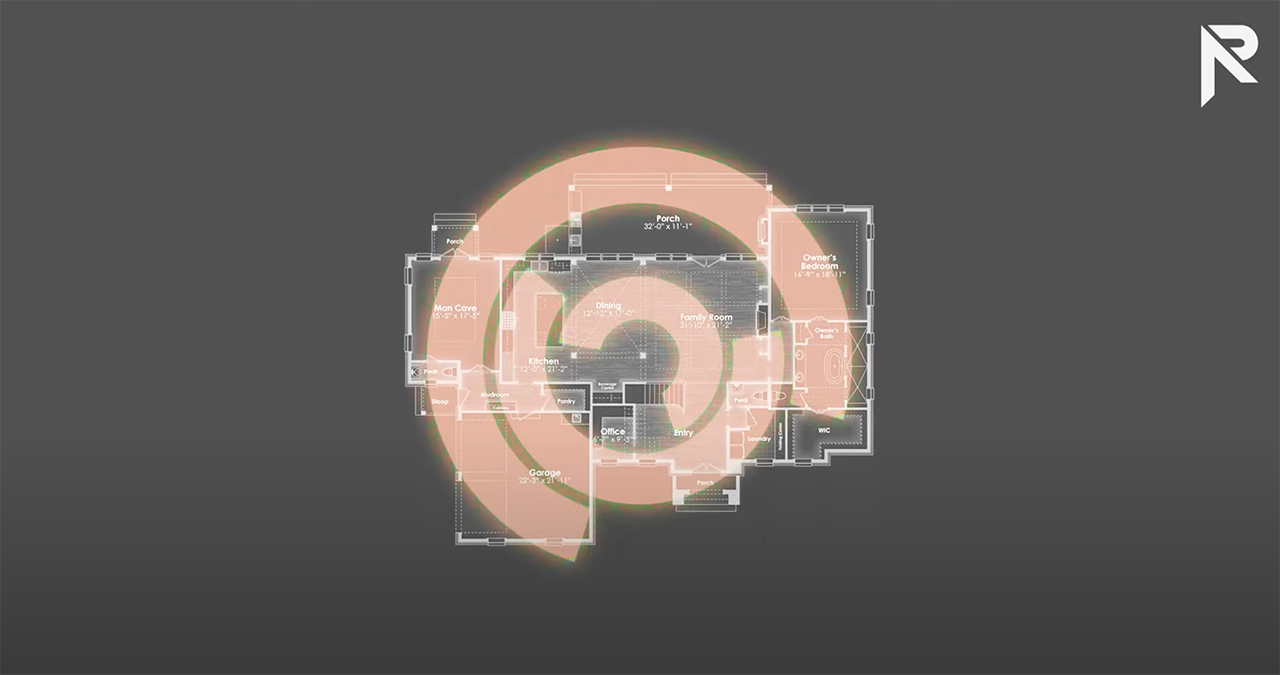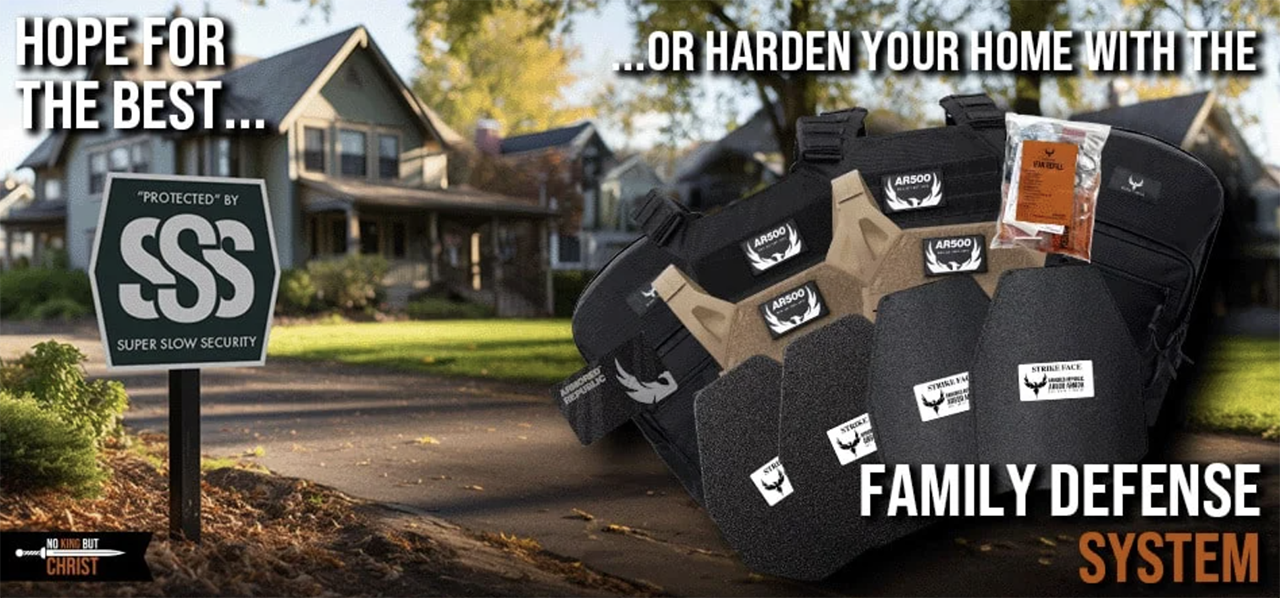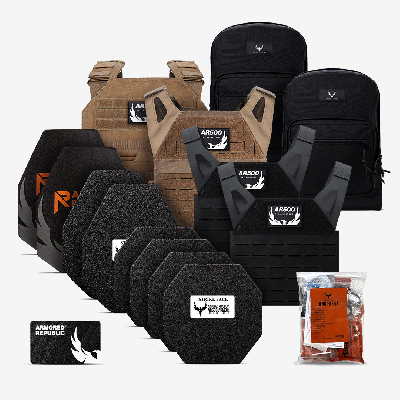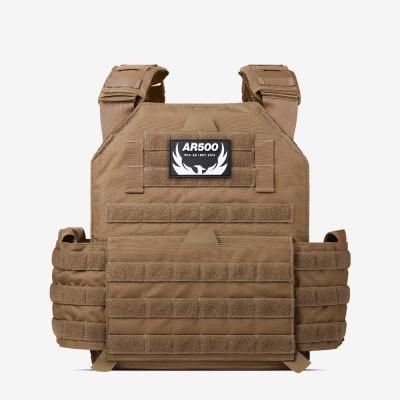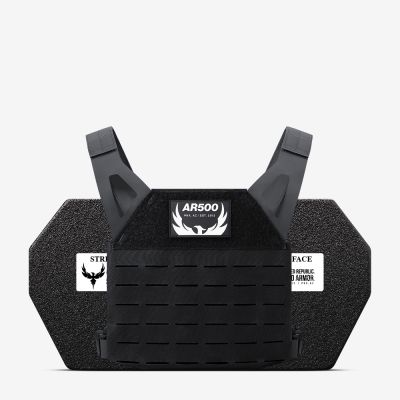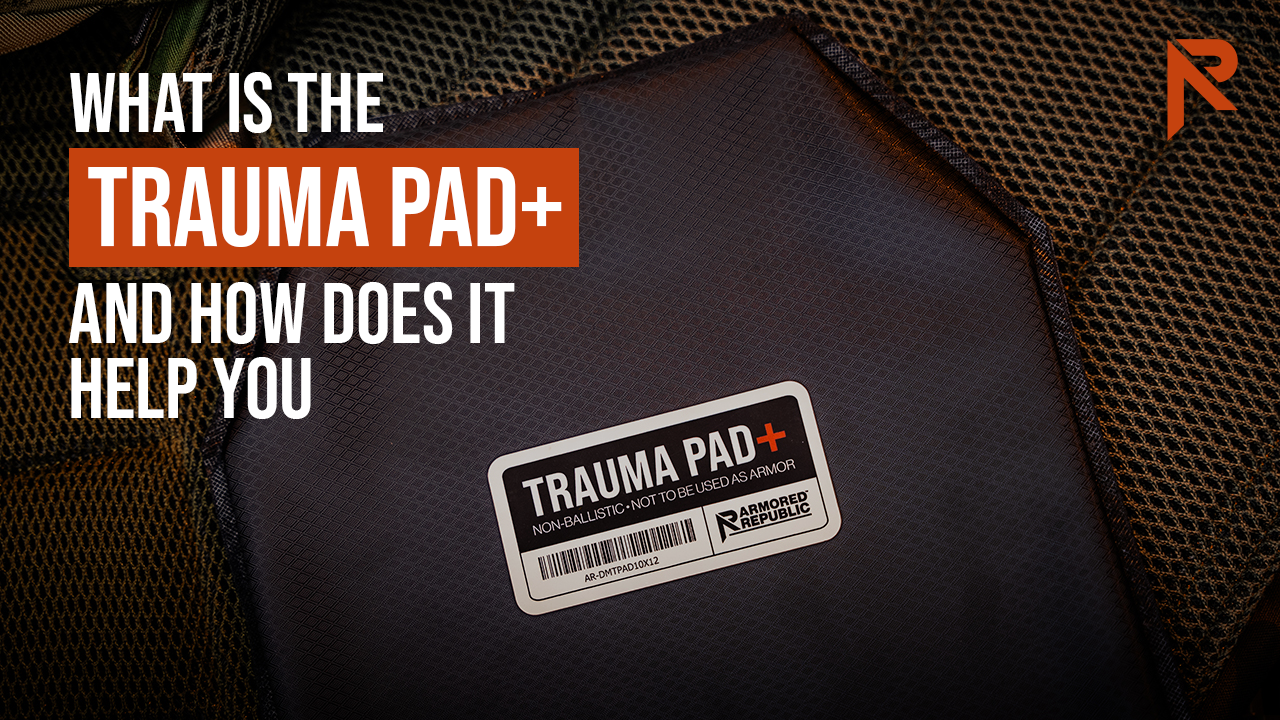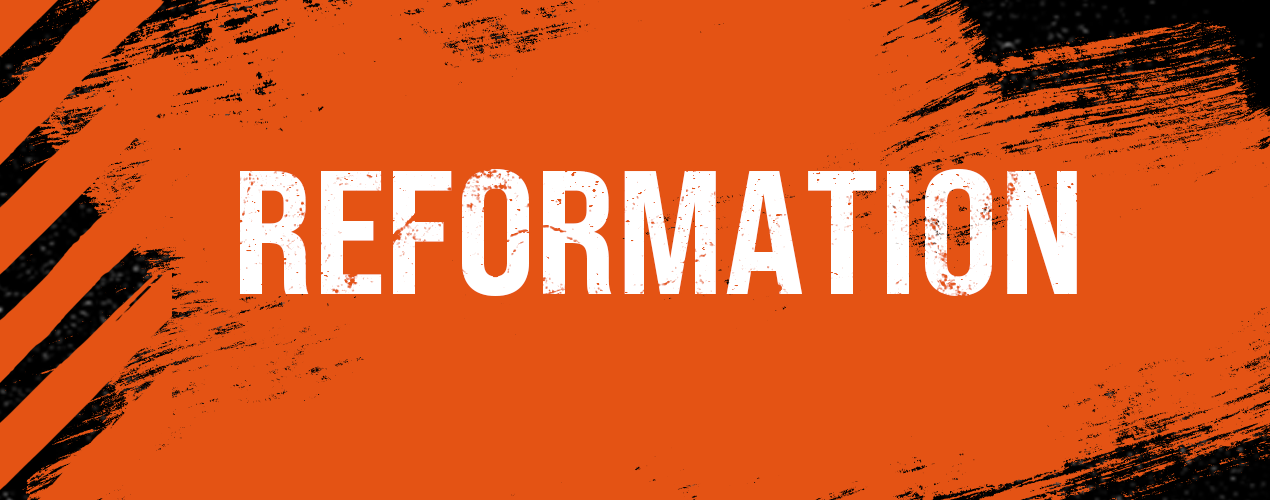What is the Best Way to Prevent a Home Invasion? - Haden Your Home Series
- By AR500 Armor
- Apr 15, 2024

Securing Your Home: Understanding and Combatting Home Invasion Threats
The Stark Reality of Home Invasions
According to the US Department of Justice, every year, there are over 1.65 million home invasions, shattering the peace of countless families and highlighting a critical need: the fortification of our homes and properties. This staggering statistic isn't just a number—it's a wake-up call, urging us as providers and protectors, to take action and ensure our homes are not part of this grim reality. As the defender of your home, you have the God ordained duty to ensure the safety and security of those under leadership and care.
Embracing Home Hardening
Taking on the security of your home is integral to fulfilling your role as the family's head and protector. This responsibility transcends the basic provision of needs, and requires you to think about, plan and implement various safety and security protocols for your home. Embracing this role means equipping yourself with knowledge and the right tools, delving into home security principles, and understanding potential threats. Implementing a comprehensive defense strategy not only safeguards your home but also embodies a commitment to protect those entrusted by God to your care. Through proactive planning and preparedness, you're not just defending a physical space; you're honoring your duty to ensure the well-being and safety of your family.
Developing a Defensive Mindset
In discussing home security, a pivotal element is cultivating a defensive mindset. This approach prioritizes readiness and awareness over fear, empowering individuals with the knowledge and preparation needed to protect their homes effectively.
Understand the Threat
To foster a defensive mindset, begin by seeing your home through the eyes of a potential intruder. Identifying vulnerabilities, such as easily accessible windows or inadequately secured doors, is crucial. Recognizing these potential entry points and areas of concealment allows you to address and fortify them, making your home a less attractive target for burglars.
Layered Defense Strategy
A comprehensive defense strategy involves multiple layers of protection. The outermost layer focuses on deterrence—implementing visible security measures like motion sensor lights and security cameras to discourage would-be intruders. Following this, early warning systems such as doorbell cameras and motion detectors play a vital role, alerting homeowners to a threat at the earliest possible stage and allowing time to take action.
Preparation and Training
Beyond physical security measures, a defensive mindset emphasizes the importance of personal preparation and training. This includes having a clear plan for various emergency scenarios, whether that involves barricading yourself and your family to stay safe, planning escape routes, or understanding when and how to confront an intruder if necessary. Training and practicing these plans with your family ensures that everyone knows what to do in an emergency, significantly enhancing your home's security and your collective safety.
By methodically assessing your home's security, implementing strategic defenses, and preparing for potential scenarios, you can cultivate a mindset that prioritizes safety and readiness, ensuring peace of mind in an unpredictable world.
Assessing Your Home's Vulnerabilities
Identifying Weak Points
To fortify your home effectively, it's essential to step into the shoes of an intruder. Viewing your home from a criminal's perspective can unveil vulnerabilities you might have overlooked. This approach involves a critical assessment of your home's exterior and interior, identifying potential entry points and areas that could provide cover for unauthorized access.
Conducting a Perimeter Walk
Start with a perimeter walk around your property, preferably during different times of the day. Look for places where visibility is low, such as overgrown bushes or dark spots that street lights don't reach. These areas can offer intruders concealment. Assess all potential entry points, not just doors and windows, but also less obvious ones like basement entrances and garage doors.
Check the strength and integrity of doors, windows, locks, and even the construction materials of your home. A weak door frame or a window that's easily jimmied open can be an invitation to enter. Pay special attention to sliding doors, which are often an easy target due to their standard locking mechanisms being less secure.
Evaluating Security Measures
Assess existing security measures. Do you have motion sensor lights, security cameras, or alarm systems in place? How visible are these deterrents to a potential intruder? The mere presence of security cameras and well-lit areas can significantly reduce your home's appeal to burglars.
Prioritizing Security Measures
After identifying your home's weak points, prioritize your security upgrades. Not all security measures need to be implemented at once, especially if budget constraints are a consideration.
Starting with Simple Upgrades
Begin with simple, cost-effective upgrades. Improving exterior lighting, trimming hedges to reduce concealment opportunities, and upgrading locks can be done relatively inexpensively but have a significant impact on your home's security.
Investing in High-Impact Areas
Focus on high-impact areas next. If your front door is old and weak, consider replacing it with a solid, reinforced door and a high-quality deadbolt. If windows are easily accessible and vulnerable, invest in window locks or security film to make them more resistant to breaking.
Integrating Technology
Integrate technology into your security plan. Smart locks, security cameras, and alarm systems can be controlled and monitored from your smartphone, offering an added layer of security. While these may require a larger investment, their benefits in deterring and documenting potential intrusions can be invaluable.
Regular Reviews and Updates
Security isn't a one-time setup but a continuous process. Regularly review and update your security measures to address any new vulnerabilities and to incorporate technological advances. Keeping your home's security in line with current best practices is crucial in maintaining a safe and secure environment.
By methodically assessing and upgrading your home's security, you can create a robust defense against potential intrusions, ensuring the safety and peace of mind for you and your family.
Building Layers of Home Defense
The 5 D's of Home Defense
The "5 D's of Home Defense" is a strategic framework extensively utilized by home defense instructors to create robust home protection plans. This method involves Deter, Detect, Deny, Delay, and Defend—each step building on the last to establish a comprehensive defense from the outer perimeter of your property to the inside. Let's explore each of these crucial components and how they collectively strengthen your home's security.
1. Deter
Making your home less attractive to potential intruders is the first crucial step. This involves managing the visibility of valuables to prevent them from drawing attention. Here are specific measures to enhance deterrence:
- Conceal Valuables: Keep personal items and expensive electronics out of sight from windows. Avoid displaying signs of wealth that might attract attention.
- Secure Entry Points: Ensure that windows and garage doors are kept closed and locked when not in use.
- Regular Maintenance: Keep your property well-groomed. A tidy and attended property can discourage potential intruders by signaling vigilance.
- Signage: Display signs that indicate the presence of a security system. These serve as a simple yet effective warning that may deter potential burglars.
- Lighting: Install adequate exterior lighting, such as floodlights, porch lights with motion sensors, and garden lights along pathways to eliminate dark spots and shadows where intruders could hide.
- Visible Security Measures: Set up visible security cameras (real or dummy) and window stickers signaling an alarm system to increase the psychological barrier to entry.
2. Detect
The ability to detect an intruder early can significantly enhance your home defense. Employing various technologies and natural deterrents can help:
- Surveillance Equipment: Equip your home with security cameras and motion sensors that trigger lights or alarms, alerting you to any movement around the perimeter.
- Doorbell Cameras and Motion Detectors: These tools help you monitor and communicate with anyone at your doorstep from anywhere, adding a layer of security by alerting you to entry attempts.
- Door Intercoms: Use intercom systems to verify visitors without opening the door.
- Pet Dogs: A dog can be an excellent alert system, barking at unusual activities or intruders.
- Enhanced Visibility: Trim foliage and avoid high fences to maintain clear lines of sight. This not only enhances the beauty of your home but also removes potential hiding spots for intruders.
3. Deny
Preventing access to your home is essential for keeping intruders out. Reinforce your home’s physical barriers with:
- Strengthen Entry Points: Ensure all doors and windows are secured with high-quality locks and consider upgrading to smart locks that alert you to unauthorized access attempts.
- Hostile Landscaping: Plant thorny bushes or cacti under windows to deter window entry.
- Security Films: Apply security films to windows to make them harder to break.
- Hostile Landscaping: Plant thorn bushes or cacti beneath windows to physically deter any attempts to enter through these vulnerable points.
4. Delay
Slowing down an intruder can provide crucial minutes needed for law enforcement to arrive. Implement features that complicate entry:
- Security Screens: Install screens that are difficult to cut or remove.Fenced Perimeters: Enclose your property with a fence to slow down unauthorized access.
- Window Bars: Fit bars on lower-level windows to prevent easy entry.
Reinforced Barriers: Strengthen door frames to resist forceful entry. Install security screens, use window bars, and strengthen doors with longer screws in hinges and strike plates to delay entry. - Entry Point Security: Use high-quality deadbolts, security films on windows, and ensure garage doors are sturdy and possibly integrated with entry sensors.
5. Defend
When all other measures fail, being prepared to defend your home physically is critical. Prepare for this final stand with:
- Safe Room: Designate and equip a safe room for hiding and protection during a break-in.
- Emergency Call: Have a phone accessible to call 911 in an emergency.
- Self-Defense Training: If legal in your area, receive training on using firearms or other self-defense tools responsibly. Get acquainted with your local laws, understand your options and plan accordingly.
Integrating the 5 D's into your home security plan transforms passive safety measures into an active and layered defense strategy. This approach ensures you are prepared to deter, detect, deny, delay, and defend against potential threats, ultimately providing peace of mind in an unpredictable world.
Home Defense Readiness: Training, Preparation & Action
Developing a Defensive Mindset
In the face of a potential home invasion, the right mindset can make all the difference. Preparing mentally involves recognizing the reality of threats and understanding that readiness can significantly impact outcomes. Developing a defensive mindset includes:
- Awareness: Being constantly aware of your environment and any changes or anomalies.
- Preparation: Having plans for various scenarios, including intrusion, natural disasters, and medical emergencies.
- Training: Regularly practicing your response to different emergencies, both individually and with family members.
- Use of Violence: Understand a home invader may be coming into your home to cause you and your family bodily harm, or even death. You need to not only be aware of this but know violence is the only thing they will understand. Your ability to wage asymmetric violence better than your attacker to “speak their language” is how every violent encounter has been resolved. Act accordingly when your family is on the line.
A defensive mindset isn't about living in fear but about empowerment. Knowing that you have the knowledge and skills to protect yourself and your loved ones provides peace of mind.
Actionable Home Defense Tactics
In the regrettable event of a home invasion, having a clear plan of action is crucial. Here are steps to consider:
- Identify Safe Zones: Establish safe areas in your home where family members can retreat if necessary.
- Escape Routes: Know how to exit your home quickly and safely from multiple locations.
- Fight or Flight: Assess whether to confront an intruder or escape. This decision depends on many factors, including the threat level and your capability to defend yourself.
- Communication Plan: Have a way to communicate with family members during an emergency, including code words that signify danger or the need to evacuate.
Emergency Contacts: Ensure all family members know who to call in an emergency, including a designated meeting point outside the home if separation occurs.
Importance of Having a Plan
- Reduces Panic: Knowing what to do provides clarity in chaotic situations, reducing panic and increasing the chances of a positive outcome.
- Improves Response Time: Practiced plans become instinctual, allowing for quicker reactions to threats.
- Family Coordination: Ensures that all family members know their role and how to support each other during a crisis.
Regular drills and discussions about these tactics ensure that, in a moment of crisis, every family member knows exactly what to do, significantly improving the chances of navigating a home invasion safely. The Family Defense System by Armored Republic, combined with a solid defensive strategy and actionable tactics, equips families with the tools and knowledge needed for comprehensive home protection.
Empowering Your Home Security
In this guide, we've addressed the stark reality of home invasions and underscored the critical need for a multi-layered defense strategy. Each step—from understanding deterrence psychology to assessing and fortifying home vulnerabilities—builds a comprehensive security plan.
- Understanding Deterrence: We began by exploring how visible security measures like cameras and lighting can deter potential intruders by signaling heightened risk.
- Assessing Vulnerabilities: Identifying and strengthening weak points in your home's defenses, such as unsecured windows or doors, reduces the likelihood of intrusions.
- Building Layers of Defense: We discussed adding physical and technological barriers that delay and deny entry, providing more time to respond to an intrusion and complicating the intruder’s efforts.
- Preparedness & Action: Despite all precautions, it's vital to prepare for potential breaches with a solid action plan and training in emergency protocols and self-defense.
As the protector and defender of your domain and your family, it is essential that you take every aspect of home security seriously.You are responsible for the safety and well being of your loved ones; not the government, you! By integrating these elements into your home defense strategy, you create not just a safe space but a well-protected fortress, ready to withstand potential threats while ensuring the safety and peace of mind for your family.
The Family Defense System by Armored Republic
At the heart of our recommended strategy for ensuring home safety is The Family Defense System by Armored Republic. This comprehensive system is more than just a set of tools; it provides peace of mind with its array of advanced armor and essential medical supplies. Tailored to meet the needs of every household, this system exemplifies our commitment to proactive measures over reactive responses, ensuring the safety and well-being of families.
Components of the Armored Republic Family Defense System
Body Armor & Plate Carrier Solutions:
The Family Defense System is meticulously assembled to cater to various protection needs, combining high-quality body armor solutions and versatile plate carrier options to ensure maximum safety and comfort for all family members. Here’s a detailed breakdown of the components included in this system:
- Testudo Lite & C3 Body Armor:
- Plate Carrier: 1 x AR500 Armor® Testudo™ Lite Plate Carrier in Black, offering a lightweight, adaptable fit for rapid deployment and high-stress scenarios.
- Armor Plates: 2 x Level IV C3 Multi-Hit Multi-Curve Body Armor, providing comprehensive protection against high-caliber threats with its advanced ceramic and polyethylene construction.
- AR Freeman Bundle x2:
- Plate Carriers: 2 x Freeman Plate Carrier in Black, designed for quick movement and discreet protection.
- Armor Plates: 4 x A2 Plate - 9"x9" Base Coat, perfectly sized to protect vital body organs from various ballistic threats while maintaining a compact and manageable profile.
- Invictus 2.0 Plate Carrier Bundle:
- Plate Carrier: 1 x AR Invictus Plate Carrier in Coyote - Gen 2 - Medium, featuring modern tactical advancements with enhanced load-bearing capabilities and a quick-doffing system.
- Armor Plates: 2 x A2 Plate - 10" x 12" Base Coat, providing robust defense against higher velocity rounds, suitable for both frontline and emergency response scenarios.
Medical Equipment:
- Individual First Aid Kit (IFAK): Available as an optional add-on, an IFAK is a critical component for managing injuries until professional medical help can arrive. The AR IFAK V2 is stocked to treat massive hemorrhage, airway maintenance issues, hypothermia, and more, ensuring readiness for a range of medical emergencies.
Ease of Use:
- The Family Defense System is engineered for quick deployment, ensuring that protective gear can be donned swiftly and efficiently, even under high-stress conditions. This accessibility is crucial in emergencies, providing family members the ability to react quickly and effectively.
Additional Features and Accessories:
- Phoenix Armored Backpacks: Discreet yet effective, these backpacks include sewn-in Level IIIA soft armor panels for protection against handgun threats, ideal for everyday carry.
Each component of these body armor configurations were selected to offer the best in modern ballistic protection technology, ensuring that every member of your family can feel secure and prepared, whether at home or in a situation that requires rapid evacuation. The strategic combination of lightweight carriers and heavy-duty armor plates balances comfort with exceptional defensive capability, making the Family Defense System by Armored Republic an unparalleled choice in home defense solutions.
This system isn’t merely about defense; it’s about ensuring a level of preparedness that can significantly alter outcomes in critical situations. By choosing the Family Defense System by Armored Republic, you're not just purchasing equipment—you're investing in a comprehensive protection solution for your loved ones. Equip your home with the defense system it deserves and experience the peace of mind that comes with knowing you are well-prepared to protect your family.

